Key takeaways:
- Women’s health advocacy is crucial for addressing healthcare disparities and ensuring women’s voices are heard, particularly in reproductive health.
- Reproductive rights are fundamental for individual autonomy and community health, influencing socioeconomic conditions across generations.
- Access to reproductive health services faces numerous challenges, including inadequate infrastructure, cultural stigmas, and restrictive laws, which impede women’s ability to receive care.
- Grassroots movements and comprehensive education programs play vital roles in advocating for reproductive rights and empowering individuals to challenge existing norms.
Understanding women’s health advocacy
Women’s health advocacy is essential in ensuring that women receive the healthcare they deserve, free from stigma and discrimination. I remember attending a community health workshop where women shared their stories about navigating healthcare systems that often overlook their specific needs. This experience left me wondering: how many women silently suffer because their voices aren’t heard?
The more I engage with this topic, the more I realize that advocacy isn’t just about policy; it’s about personal experiences that shape our understanding of health. For instance, when a close friend faced challenges accessing reproductive care, it illuminated the gaps in our healthcare system. Isn’t it unsettling to think that these challenges can complicate what should be a fundamental right?
Moreover, women’s health advocacy includes addressing the intersectionality of various identities, including race, socioeconomic status, and geographic location. I’ve often been struck by how different factors can create barriers to adequate care for some women while others navigate the system without a hitch. Why is it that some women have such a different experience than others, even within the same community? This disparity fuels my passion for advocating for a more inclusive approach to women’s health.
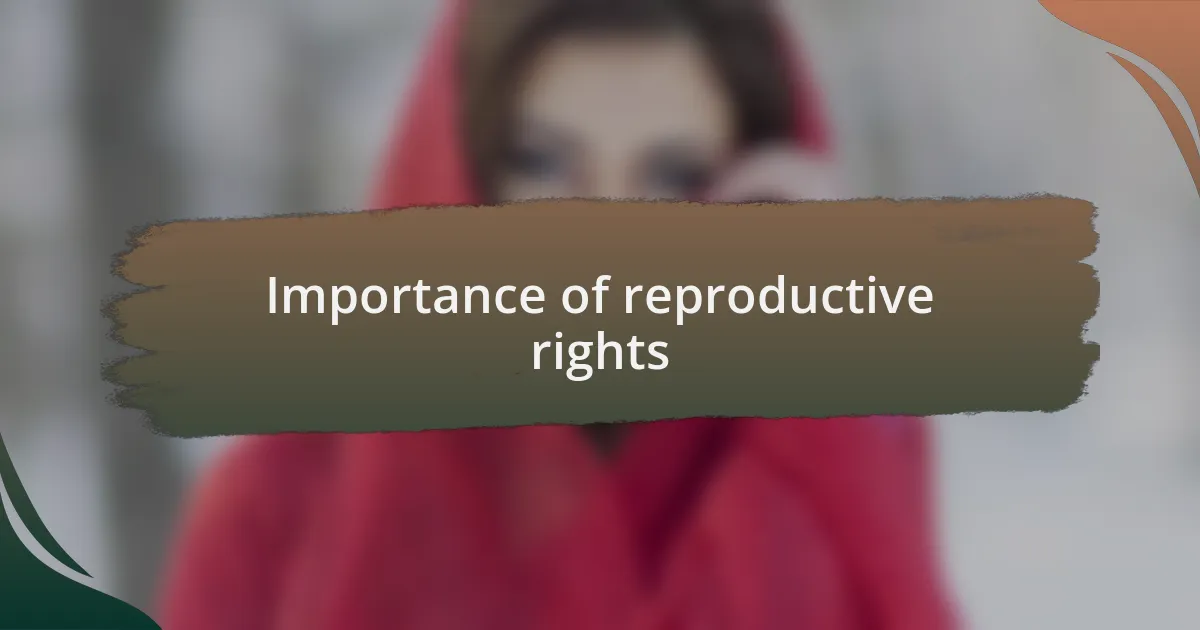
Importance of reproductive rights
Reproductive rights are fundamental to women’s autonomy and dignity. I remember visiting a clinic with a young woman who felt terrified and alone, grappling with life-altering decisions about her future. Watching her navigate that emotional turmoil made it clear to me that when women have the right to make choices about their reproductive health, they can better control their life trajectories. But what happens when those rights are stripped away?
The importance of reproductive rights extends beyond individual choice; it influences community health. For instance, I’ve seen families affected when women cannot access safe reproductive care. Imagine a community where unwanted pregnancies lead to increased poverty and decreased educational opportunities. Isn’t it heartbreaking to think that denying women their reproductive rights can ripple through generations, affecting not just individuals but entire communities?
Moreover, access to reproductive rights is closely tied to health equity. In my advocacy experience, I’ve encountered women who faced unimaginable obstacles simply because of their socioeconomic background. How can we stand idly by when the right to health care—something I’ve always considered fundamental—is met with barriers for so many? Addressing this issue is not just about reproductive health; it’s about justice and equality for all women, regardless of their circumstances.
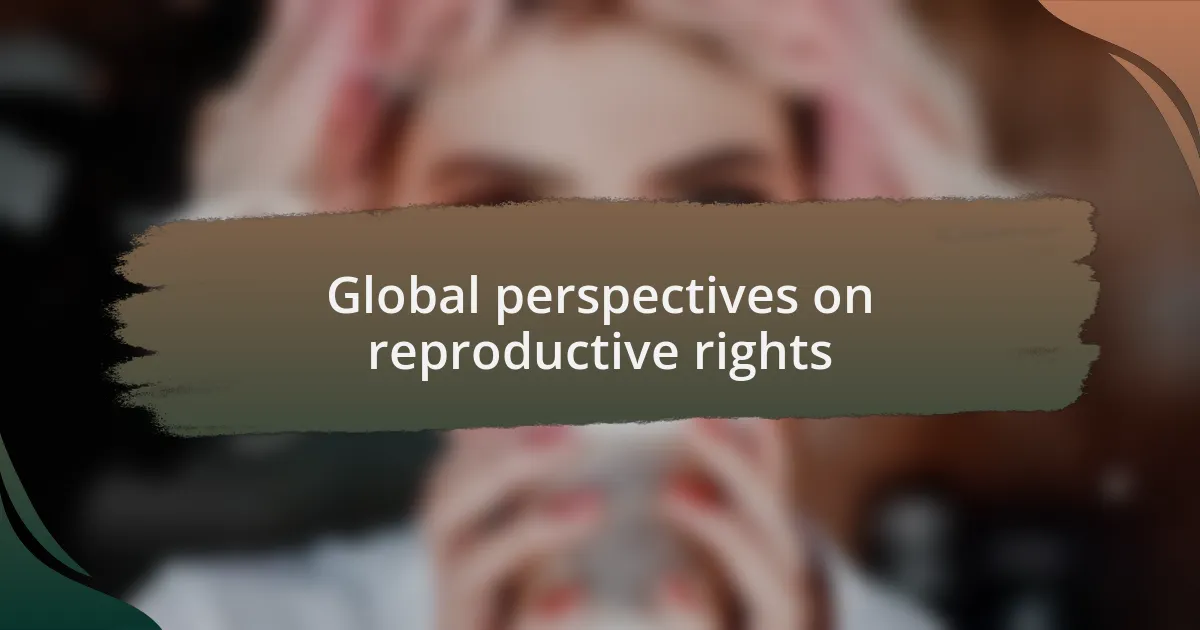
Global perspectives on reproductive rights
Reproductive rights differ dramatically across the globe, shaped by cultural, political, and economic contexts. During my travels, I observed stark contrasts in attitudes towards reproductive health. In some countries, women possess autonomy over their bodies and choices, whereas, in others, rigid laws and societal norms heavily restrict them. I can’t help but wonder—how do women in these restrictive environments find their voice amidst such silence?
Moreover, I’ve seen firsthand how international organizations advocate for change in regions where reproductive rights are limited. A friend of mine worked tirelessly in a community that faced severe backlash for discussing family planning. She’d often share how the fear of repercussions didn’t deter these women; instead, it ignited a passion for their rights. It made me realize that advocacy doesn’t just emerge from comfort; it often arises from struggle and resilience, pushing for progress even when the odds are stacked against them.
Looking at countries where reproductive rights are recognized, it’s clear that access to education and healthcare plays a crucial role. The stories I heard from women in those regions were powerful—many credited their ability to plan their families with financial stability and personal empowerment. Isn’t it astonishing how connected these themes are? When women can decide when and if to have children, they can pursue careers, education, and passions, truly transforming their lives and communities.
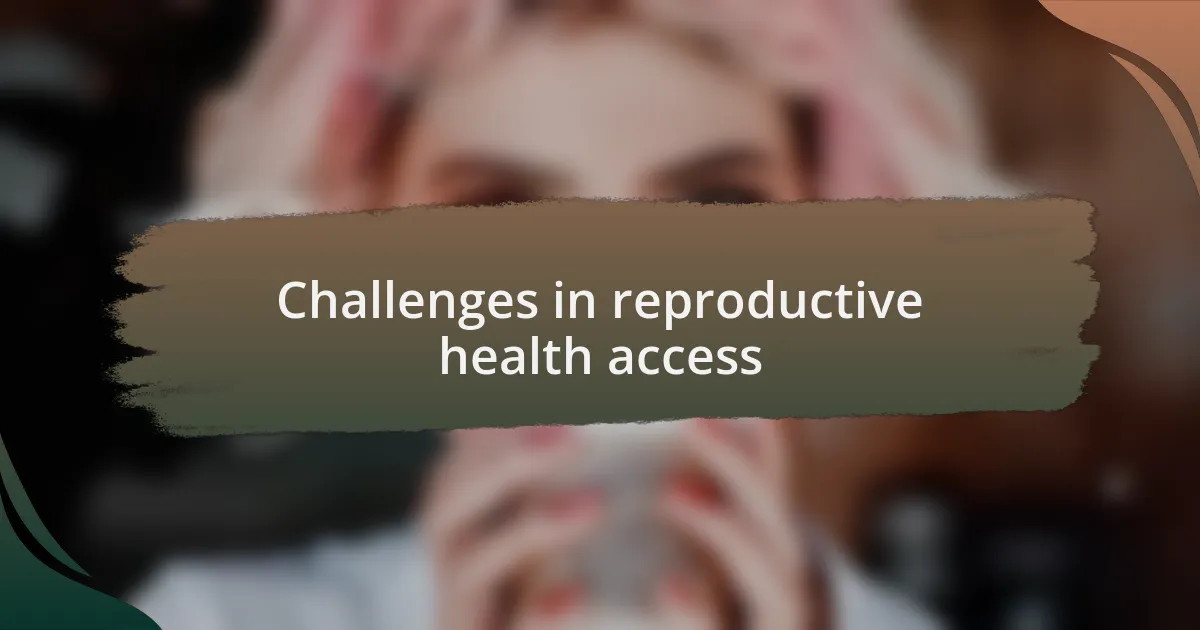
Challenges in reproductive health access
Access to reproductive health services is often plagued by numerous challenges, which can feel overwhelming. In remote regions I’ve visited, inadequate healthcare infrastructure dramatically limits women’s ability to receive essential services. I remember speaking with a group of women who had to travel hours, sometimes through treacherous terrain, just to seek basic reproductive care. How can we expect women to prioritize their health when the very system meant to support them is falling apart?
Cultural stigmas also play a significant role in obstructing access to reproductive health. I once attended a workshop where a local activist shared her struggles to change community attitudes about contraceptives. The whispers of disapproval echoed in the room as she bravely recounted her experience. This has made me reflect: how do we begin to break down these barriers when silence often feels safer?
Furthermore, legal restrictions often compound existing issues, creating an intricate web of challenges. In my research, I found that in certain countries, laws surrounding reproductive health not only limit access to services but also criminalize the very act of seeking care. Listening to stories from women facing potential imprisonment for exercising their rights was both heart-wrenching and illuminating. It truly made me realize—the legal landscape in which women navigate their reproductive health choices is crucial to fostering better outcomes.
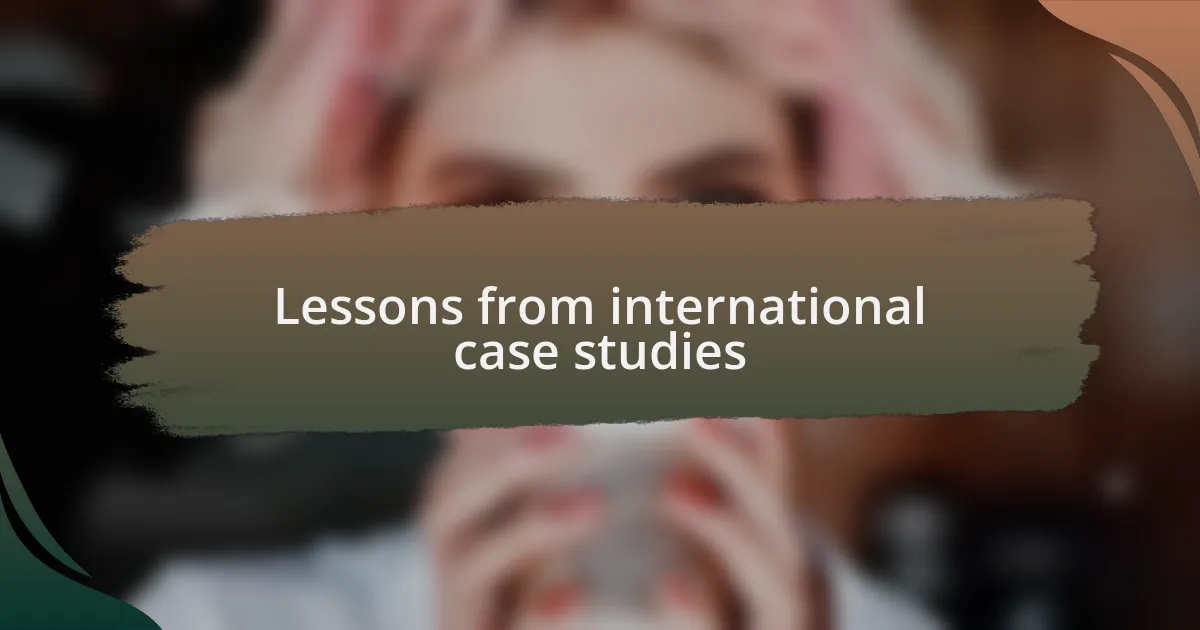
Lessons from international case studies
When examining international case studies, one common lesson emerges: the vital role of grassroots movements in advocating for reproductive rights. I recall a powerful story from a community in Bangladesh, where local women banded together to challenge restrictive laws. Their persistence not only led to increased awareness but also empowered countless others to speak up about their rights. Isn’t it fascinating how collective voices can sway even the most entrenched systems?
Another key insight is the significance of comprehensive education programs. In several countries, I’ve seen that when reproductive health education is prioritized, young people become advocates for their own rights. I once met a group of teenagers in South Africa who created a peer-led initiative that tackled misconceptions about contraceptives. Their confidence to educate each other demonstrated how knowledge can dismantle stigma. How can we not invest in this transformative power of education?
Lastly, the interplay between cultural understanding and policy implementation stands out in these case studies. In Colombia, I observed how lawmakers collaborated with local leaders to ensure reproductive health policies were culturally sensitive. This approach not only facilitated smoother implementation but also fostered trust between communities and health providers. It begs the question: how crucial is the alignment of policy with local values in creating effective health services?
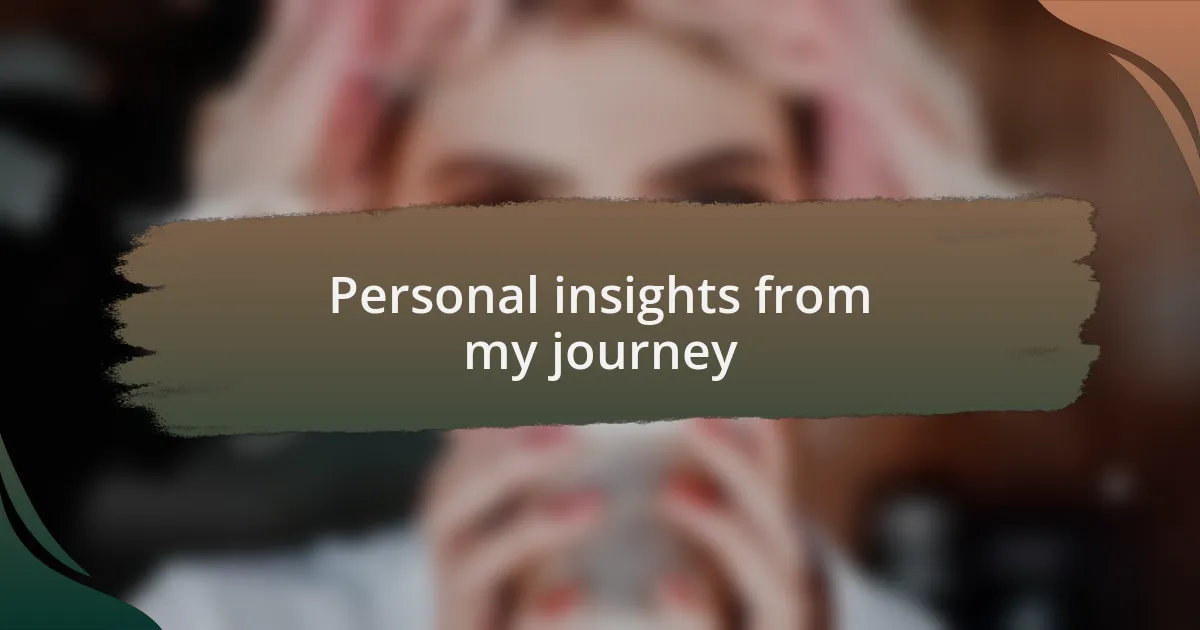
Personal insights from my journey
As I reflect on my journey through the intricate landscape of international reproductive rights, I find that personal connections have shaped my understanding profoundly. During my time in a women’s health advocacy conference, I met a survivor from a country where access to reproductive services was severely restricted. Her story moved me deeply; she shared how the lack of resources had forced her to make life-altering choices. It struck me then just how much individual experiences can fuel our collective push for change. Have you ever realized how personal stories can illuminate the often abstract issues we debate?
In my encounters with various communities, it became clear that every culture has its unique challenges and triumphs regarding reproductive rights. I remember visiting a project in Nigeria where women were not only participants but leaders in advocating for their health choices. Watching their confidence grow as they navigated discussions with policymakers left me in awe. It raised an essential question in my mind: how often do we empower individuals to take lead roles in their advocacy journeys?
Moreover, my direct involvement in campaigns showed me the importance of listening. During a workshop, I facilitated a dialogue session where women’s voices were prioritized. The insights they shared about their everyday struggles with access and education were illuminating. It made me realize that true advocacy starts when we sit back and allow those most affected to guide us. Isn’t it fascinating how listening can become a powerful tool in shaping effective reproductive health strategies?
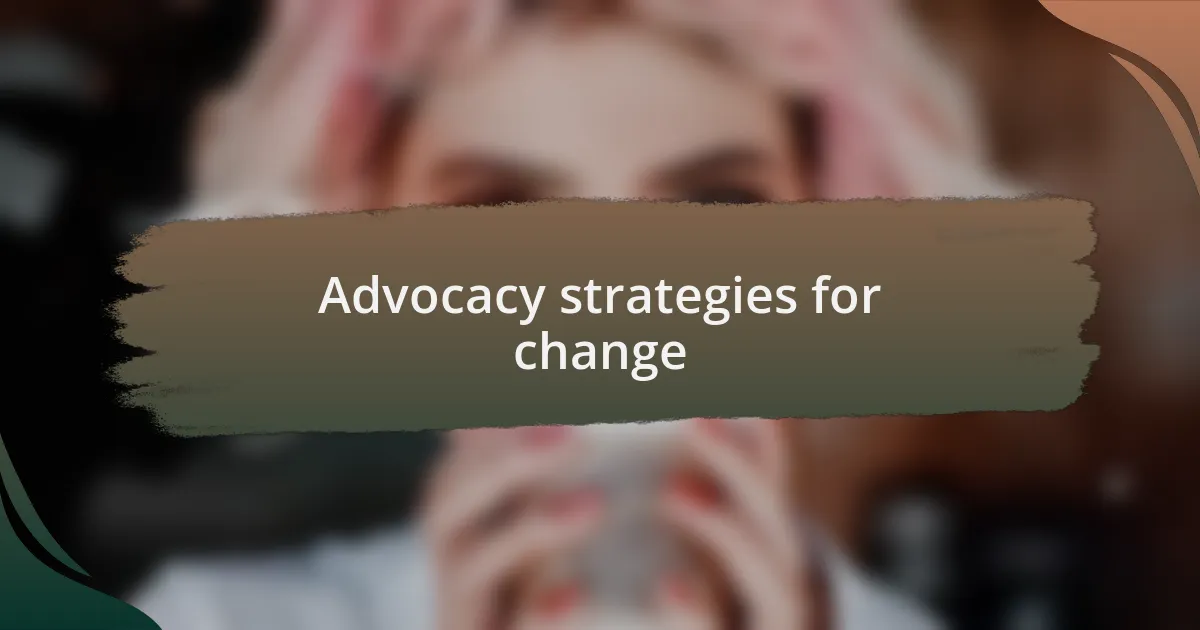
Advocacy strategies for change
Thinking back on my experiences, I’ve learned that coalition building can be a game changer in advocacy. At one point, I collaborated with local NGOs across several countries striving for reproductive rights. The synergy among diverse groups amplified our voices, allowing us to reach wider audiences and influence policy changes more effectively. Have you ever noticed how bringing different perspectives together can create a more compelling narrative?
Engaging in grassroots initiatives has also proven pivotal. I recall volunteering with a group that organized community workshops aimed at educating women about their reproductive rights. As I watched participants come alive with knowledge and empowerment, it dawned on me how critical it is to provide accessible information. Isn’t it incredible to consider how education can transform individual lives and pave the way for systemic change?
Moreover, advocacy often requires innovative approaches to thrive. In one campaign, we used social media to share impactful stories from those most affected by restrictive policies. The outpouring of support from a global audience was electrifying, illustrating the power of digital platforms in creating momentum. Have you ever thought about how these modern communication tools can bridge gaps and energize movements in ways traditional methods may not?